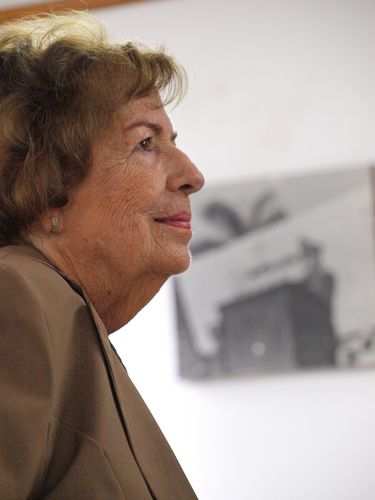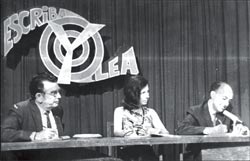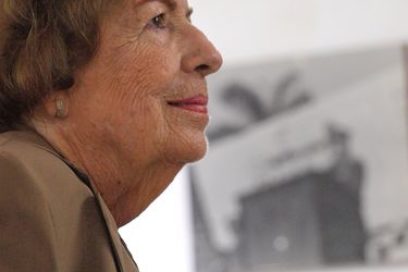
By Hassan Perez Casabona
For about five decades Cuban people have watched Maria Dolores Ortiz on TV in the famed program Escriba Y Lea (Write and Read). Don’t you think it is an Olympic record?
The fact is that Doctor Maria Dolores Ortiz is much more than the soul of Escriba y Lea, a space to dialogue to the television viewers. When we asked her for an interview, she did not hesitate to accept. So it was a great pleasure to talk to this woman awarded Worker Heroine of the Cuban Republic. We would like to thank her for letting us get inside her world.
Let’s talk about your childhood…
“I was born in Holguin and I have always felt as part of that city. I was luck to grow inside a cultured and educated family. My father was a Science Public Doctor in Laws and one of my uncles was a Science Doctor in Philosophy and Letters.
Was in your family any member of the Liberation Army?
From my mother’s relatives, one of my great-grandfathers was a Mambi (Cuban rebel). He died during the Independence War. My great-grandmother was educated and patriot. In historical days, she used to hang a Cuban flag on the grille of the living-room’s window made by her hands. My paternal grandfather was Puerto Rican follower of the independence of that brother country. He was in jail twice for articles he published in several newspapers criticizing the pro-Yankee administration. He was a poet and I could not know him.
When did you move to the capital?
I lived in Holguin until I obtained by high school diploma. I came to Havana to study Philosophy and Letters in 1953, just some weeks later the attacks to Moncada and Carlos Manuel de Cespedes Garrisons. I was a very well faculty in Dihigo building with excellent professors. Among them doctors Vicentina Antuña, Manuel Bisbe, Rosario Novoa, Camila Henriquez Ureña and Elias Entralgo.
When did you graduate?
After the triumph of the Revolution, in 1959, I stayed in fourth year with the closing of the University. I started working at Candell College. In 1960 the university called for opposition exams to work at junior high schools, I went and got the first place in Marianao municipality for a post at Jose Antonio Echevarria school at Ciudad Libertad. I worked there until 1061 when the Revolution made the call for the Illiteracy Campaign and I became member of Conrado Benitez Brigade, one of my greatest prides and I still keep the uniforms I used during the campaign.
I attended in Bello Horizonte, Brazil, to the 50th commemoration of this heroic deed. It was a great honor because that city awarded me with the condition “Honorary Citizen”.
When did you start working at the University?
There was an exodus of professors from the university and they had to hire people who had recently graduated. I started working at the Letters Faculty and the head of the department was Roberto Fernandez Retamar and he immediately sent me to a course for Radio and Television broadcasters delivered by Doctor Elias Entralgo. In the group there were Cepero Brito, Enrique Goizueta, Franco Carbon, Hector Fraga who were not graduated from college. We studied Geography, Art History, Grammar, Redaction and other important subjects. It was a good group and they all agreed I should work on Television.
Years later, Cepero Brito was in charged to the new program Escriba y Lea and he suggested I should work there. I said no, of course. Every time I thought about it, I was scared. Nevertheless, I decided to do it and whether you believe it or not, after 45 years in this program, I am still learning.
Who suggested this program?

Several comrades did together leaded by Doctor Humberto Galich Menendez. He was an amazing personality, he knew about anything. Sometimes, when we did not guess what it was, doctor Sosa used to say: “…if Galich Menendez were here, he would have given the correct answer…”
Doctor Galich Menendez was a veterinarian and he taught at La Quinta de los Molinos and he later worked at Fructuoso Rodriguez Agriculture University.
Have the records been counted?
We have never done that, because Escriba y Lea is not patrimony of one person. I have to take into consideration all what was said and asked by the rest, take into consideration the information they have got. The successes and failures are collective. That has been our goal since the first program was broadcasted on December 5, 1969, just a day after the prestigious teacher Juan Formell founded the Orchestra Los Van Van.
Has the program had the same format?
At the beginning we did not aske if the event had taken place in the solid are of the planet. One day the program was about Trafalgar Battle and we could not respond. Since that moment on we realized we should ask if the event took place on earth or on the sea.
After the emblematic Cepero Brito, who were the others who conducted the program?
There were several, but they did not want to continue. I remember Fernando Guardado, Enrique Nuñez, Gretchen Galindo. Many said there was a lot of stress during the program. There was also Angel Darana, someone completely different to Brito’s personality. We also had one of my students, Armando Calderon. At present we have Eduardo Mora, a very nice person.
Do you know if there are similar programs abroad?
I know for instance that in Spain there are programs that include panelists, but they do not have the same goal. They are contests with money interest. I believe there is none, at list in Latin America.
I guess you have received lots of recognitions…
I have been awarded by almost all the social and gross root organizations besides many from Culture. I am a Merit Artist from the Cuban Institute of Radio and Television (ICRT), what sometimes makes me laugh because I am not an artist, of what 3we know an artist is.
I cannot stop asking you about the peculiar pen you use in the program. Is it a sort of a talisman?
It is a gift from one of my students in a Mother’s Day 37 years ago inside a case. I believe it is so pretty and elegant that I decided to only use it in Escriba y Lea. But, unconsciously it has turned into a symbol. Many people ask me if it is the same, or if it has run out of ink. Even the caricaturists have included it when they draw. It just happens with some of the objects we have in life.
Which is your favorite topic?
I prefer literature. We do not take into consideration the good and bad results, but I answer quite lots of questions about history and many think I am a teacher of that subject. But I have studied it by my self.
Are you satisfied with your job?
I have spent decades receiving the love of our people. I say like Marti and Fidel that all the glory of the world fits inside a grain of corn. I do not boast for all I have received. I have devoted my social function, conscious of my responsibility. That pleasure is a trophy without paradigm.


